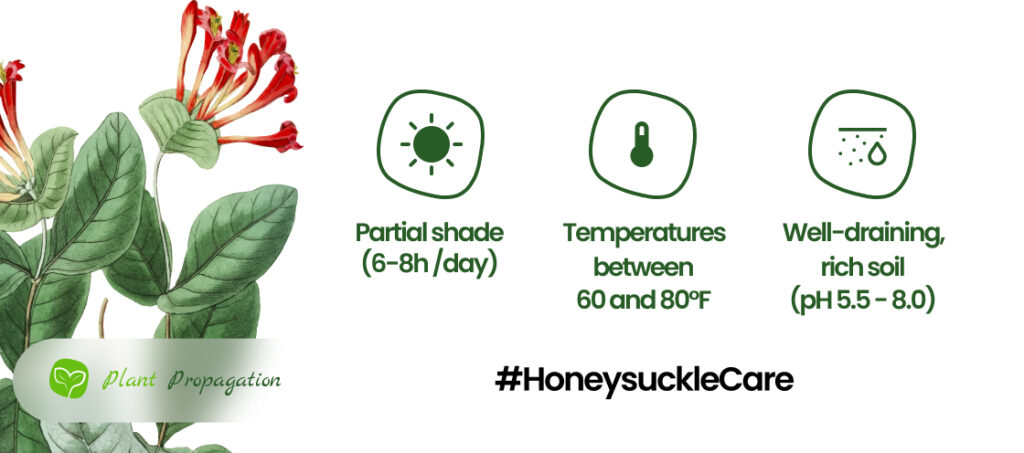
Welcome to the world of honeysuckle pruning! Explore the practical aspects of it in our full guide on why and how to prune. Learn how timely trimming not only enhances your honeysuckle’s appearance but also shields it from potential weather damage. From strategic cuts for new growth to the tools you need, we’ll guide you through the whole process so your honeysuckle can look great and while staying healthy. Let’s learn how to Prune Honeysuckle the right way!
Why you should prune your Honeysuckle
Pruing is a key step in keeping your honeysuckle in top shape. While honeysuckle typically maintains a pleasing form on its own, a well-timed trim enhances its natural beauty. Those long, unruly branches might make your honeysuckle look a bit worse for wear, creating a messy appearance.
But it’s not just about looks – pruning is a protective measure too. Trimmed branches that are kept close to the plant’s main structure are less likely to suffer damage during high winds or storms. By maintaining uniformity in branch size, you minimize the risk of breakage and ensure your honeysuckle stands strong against the elements.
Additionally, a strategic hard cut before new growth emerges works wonders. It stimulates the plant to send out fresh shoots and encourages the development of healthier, more robust branching.
The result? A dense, full shrub that not only looks fantastic but also thrives in its environment.
When to Prune Honeysuckle
Timing is pretty important when it comes to honeysuckle pruning. Start after the flowering season (April – June) to promote robust growth. A gentle trim invigorates the current season’s vitality in late summer or early autumn. If you have deciduous honeysuckle, plan for some harder pruning during late winter or early spring, taking advantage of the plant’s dormant phase to achieve a rejuvenated and thriving shrub.
Very important! Don’t rush into pruning your Honeysuckle too soon – it might not bloom well or could even harm the whole plant. Give it a good two years to grow before considering any trimming.
Tools for Pruning
Most of the time, having sturdy (and clean!) pruning shears plus a pair of gloves for protection will be enough, but if your honeysuckle has some thicker branches or vines, you might need a lopper or a pruning saw.
Whenever you are pruning, you can’t forget to clean your tools before and after, because this is one of the best ways to avoid spreading diseases.

How to Prune Honeysuckle
Basic Shrub pruning
- Prune your honeysuckle bush between April and June, post-flowering, focusing on branches that didn’t produce leaves or blooms.
- Identify and remove dead, damaged, or diseased branches, noting any signs of pests or wilted leaves, especially at the plant’s base.
- Cut at a 45-degree angle to facilitate water runoff and prevent stem rot; avoid cutting straight across to deter pests.
- Trim branches 1⁄4 inch in front of a bud to stimulate regrowth, locating buds where leaves or other branches intersect.
- Enhance light and airflow by selectively removing a few branches from the middle, pruning them to a bud near the center for increased sunshine and overall bush growth.
Pruning Neglected Honeysuckle Vines
Neglected vines pose a dual challenge – not only is selective pruning impossible due to the overgrowth, but the dense upper layer prevents sunlight from reaching the lower branches.
- Hardpruning: One way to breathe new life into severely overgrown honeysuckle, is by cutting back the plant in the winter to about a foot (from the ground). You trade in the following blooming, but you’ll get healthier growth. Just keep the soil moist to support the regeneration process.
- Gradual pruning: The other way to handle them is a more gradual approach. Over three years, remove one-third of the branches annually, rejuvenating the plant without creating a void in your landscape. You’ll get blooms and you’ll get a healthier plant too.
Aftercare
After pruning, there are some things you can do for your honeysuckle to help it bounce back faster.
- Water the plant thoroughly to help regeneration
- After a few days, apply a balanced fertilizer for an additional boost
- Mulching around the base helps retain moisture and suppress weeds

To sum it up
To sum it up, mastering honeysuckle pruning is not rocketscience, but there are some key things you need to keep in mind. Here’s a quick recap:
- Timely Trimming: Prune honeysuckle after the flowering season, between April and June.
- Use the right Tools: Use clean and sturdy pruning shears, gloves, and, if needed, a lopper or pruning saw.
- Basic Shrub Pruning: Follow a simple approach to encourage growth, removing dead or damaged branches.
-
Handling Neglected Vines:
- Hard Pruning: Cut back severely overgrown honeysuckle in winter for healthier growth.
- Gradual Pruning: Remove one-third of branches annually over three years for blooms and sustained health.
- Aftercare: Post-pruning, support your honeysuckle with thorough watering, balanced fertilization, and protective mulching.
Frequently Asked Questions
When should I cut back my honeysuckle?
You should prune your honeysuckle shrubs after the flowering season, promoting healthy growth. A light trim during late summer or early autumn encourages the current season’s vitality. For deciduous honeysuckle, opt for heavier pruning in late winter or early spring, capitalizing on the plant’s dormant phase for rejuvenation.
How do you prune an overgrown honeysuckle bush?
To prune an overgrown honeysuckle bush, cut it back to about a foot from the ground for a drastic rejuvenation. Severe pruning is ideal for tidying up tangled vines, and it’s best when done during the plant’s dormant phase.
Can honeysuckle be cut back hard?
If you want to do a drastic rejuvenation on your honeysuckle bush, you can prune it back hard in late winter or early spring.
